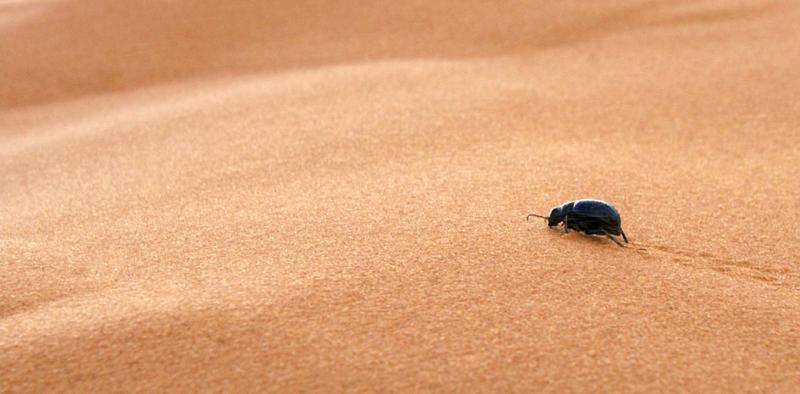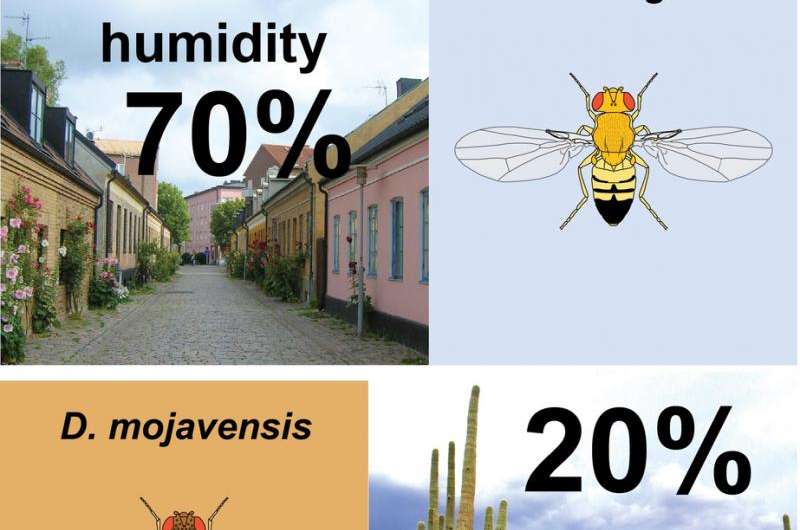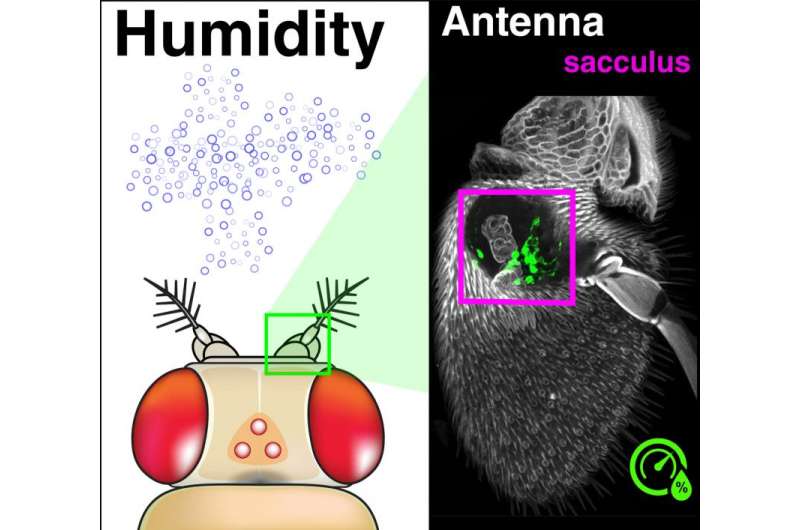A 'sixth sense' for humidity helps insects stay out of climatic trouble

The amount of water vapor in the air – humidity – profoundly alters our experience of the environment around us. A hot, dry morning in the desert of California feels miles apart from a hot, sticky one in the Cambodian jungle.
People generally dislike hot and humid conditions for good reasons. Our bodies dissipate heat through evaporation of sweat from the skin surface. When humidity is high, this process is less effective, and more blood needs to be pumped to the skin for cooling. This results in fatigue and can ultimately lead to hyperthermia ("heat stroke").
Varying levels of humidity characterize all habitats on our planet. Animal species have evolved to tolerate and even to thrive in the most extreme climates, from the frozen tundras of the north to the arid deserts of the equator. It's particularly impressive that small, cold-blooded animals such as insects can flourish in cold climates as well as in desert habitats. In part, these adaptations are made possible by sophisticated sensory systems that allow them to quickly react to potentially dangerous extremes.
When it comes to air humidity, scientists have known since the early 1900s that insects possess dedicated sensory systems that detect changes in water vapor in the air. This "sixth sense" for humidity has no direct parallels in big land mammals such as us. But it serves the small critters well as they work to avoid desiccation and to find open water: for example, a pond in which to lay eggs (crucial for many species of mosquitoes). We decided to investigate how these humidity-sensing systems work in insects.
What's the neuroscience underlying the system?
Using our favorite fruit fly Drosophila melanogaster as an experimental subject, we set out to determine just how insects can detect water vapor in the air. Which neurons serve as the humidity sensors in this species? Which genes and receptor mechanisms could be used to detect changes in air humidity? How is the information about external humidity relayed and ultimately processed in the fly's brain?
First, we had to determine the favorite humidity range for our fruit fly. Flies are human commensals – literally "share food at the same table," in this case invited or not. But though they like to live with us, it turns out fruit flies prefer humidity that is just a touch higher than we do [~70 percent relative humidity (RH) – which, on a hot day, would feel pretty sweaty to us].

We also tested two related fly species that live in different habitats. Drosophila mojavensis lives in the arid deserts of southern California and Mexico, and in our lab tests showed a preference for drier environs. Drosophila teissieri lives in the rainforest, and preferred higher humidity than the two other species. This is an important result: it suggests that humidity preference is finely tuned, reflecting specific adaptations to each species' habitat.
Next, we used the powerful tools available to fruit fly geneticists to find genes that are essential for this ability to detect and respond to air humidity. In flies, we can turn genes on or off relatively easily via mutation, as well as artificially activating or silencing specific neurons to observe what happens to behavior as a result.
The logic here was simple: if we find genes that, when missing, make the flies insensitive to changes in humidity, we know those genes are normally involved in that sensory system. Once we identify those genes, we can determine where they're active so we can pinpoint which neurons serve as humidity detectors.
Long story short, we identified three related genes without which flies become "blind" to external humidity. Flies missing them show no preference at all for dry or humid air. It turned out that they function within key receptor neurons located in the antenna. They're found in an unusual little pouch in the back of the antenna called the "sacculus" (literally 'little sac') – well-protected from potential water splashes or other dangers.
These humidity detectors – termed "hygroreceptors" from the Greek word for humidity – rapidly respond to a puff of dry air, potentially alerting the animal to the fact that dangerous dry conditions are looming.
Next, we followed the projections of the hygroreceptor neurons into the brain, and discovered they end in a region right next to the one that we've previously shown is targeted by temperature receptors of the antenna. Indeed, in insects, temperature and humidity appear to be detected by distinct receptor systems. But the two will of course interact in the brain to determine how attractive a climate may ultimately be to the fly.

How evolution and engineers approach humidity
Discoveries like these reveal some of the clever ways evolution solved basic engineering problems. These solutions are invariably a source of inspiration to human engineers working on related areas. In fact, it is quite interesting to compare how flies measure humidity with how we do it.
Modern hygrometers often rely on changes in the electrical properties of a hygroscopic – "moisture-absorbing" – material. Before the reign of electronics, a number of clever strategies had been used to achieve this same goal. Some of the earliest hygrometers were likely inspired by the common "bad hair day" experience: human and animal hair are strongly hygroscopic and change in shape and length depending on air humidity.
Leonardo da Vinci built the first-ever hygrometer on this principle in 1480. A more sophisticated instrument (that can be easily built as part of a science class) is the famous "hair-hygrometer" invented by the Swiss physicist Horace Bénédict de Saussure in 1783. Here, a single human hair is extended over a pulley that operates a needle, so that changes in the hair's length can be easily measured to keep track of changes in external humidity.
As it turns out, the fly may use a very similar strategy to measure humidity: the tips of the hygrosensory neurons we discovered are located within tiny hairs (sensilla) in the sacculus. We believe mechanical deformation of these sensilla may ultimately help the fly keep track of humidity levels.
Applying hygrometer knowledge in the field
Understanding how animals sense and respond to key environmental parameters helps us understand how they adapt to their surroundings, and will help us predict what will happen to the distribution and survival of species as the climate changes as a result of global warming.
Moreover, an increasing knowledge of the cogs and gears that pesky insects like mosquitoes use to navigate their environment and find their "prey" suggests new ways to steer them away from us. For instance, researchers are working on scrambling the olfactory system of mosquitoes, which they use to locate their blood meals. Our new findings may lead to additional strategies for controlling insect populations, perhaps by leading them away from bodies of water near our cities.
Source: The Conversation
This article was originally published on The Conversation. Read the original article.
![]()

















